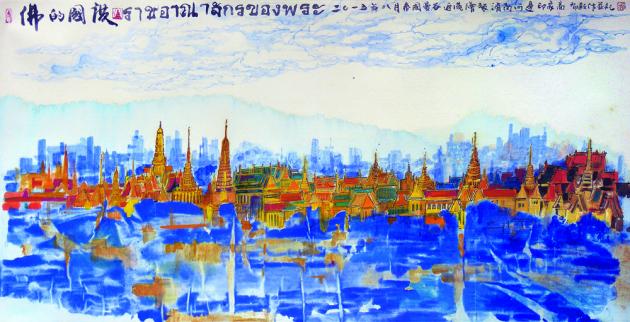The dragon swoops in

Chinese artists, bowled over by Thai scenery and culture, unveil their impressions in oil and ink this weekend
Chinese artist Kuku Chai Bukuk was deeply moved by her visits in August to the Grand Palace in Bangkok and the temples of old Ayutthaya. Now she’s back to display the painting that resulted, a rendering of venerable pagodas titled “The Kingdom of the Buddha”.
Chai Bukuk (anyone who’s passed through Terminal 1 at Hong Kong International Airport will have seen her work) is among the nine gifted “tourists” participating in the exhibition “Thailand through the Dragon’s Brushes: Chinese Artists Paint Thai Scenes”, on view all this weekend at CentralWorld. More than 80 works are included, collectively reflecting both the legacy of Chinese art and the charms of Thai culture.
“I chose Ayutthaya as my subject because it represents the golden era of the Siamese empire and the greatest achievements of Buddhist architecture,” she says through a translator, China Daily reporter Cai Xiao. “Ayutthaya is very similar to Angkor in Cambodia.”
Chai Bukuk has also depicted bright statues of the Buddha and some gorgeous landscapes, each work displaying her mastery of traditional ink and brushstroke techniques.
Led by Cai Zhixin, recognised as a National Artist in his homeland, the nine artists spent a week touring Bangkok, Ayutthaya, Chiang Mai and Lampang, gathering inspiration.
The exhibition, sponsored by The Nation, China Daily and the Chinese Culture and Arts Association, celebrates the 40th anniversary of Sino-Thai diplomatic relations. The artists gathered last Saturday for interviews at the Siam Square studio of Now 26, one of two TV channels operated by the Nation Multimedia Group.
Pana Janviroj, president of Nation News Network and Asia News Network, explained that the artists had visited World Heritage sites in Ayutthaya, temples and other cultural attractions in Chiang Mai and the Elephant Conservation Centre in Lampang, as well as Bangkok landmarks.
The artists recorded their initial impressions in sketched drawings and paintings done on-site. Tan Yan of China Daily pointed out that this was the first time they’d worked in Thailand, though some have had exhibitions here.
“I’ve travelled to many places, but never before Thailand,” said Cai Zhixin. “I’ve become very interested in Thai culture, of which there’s such abundance. Thais believe in Buddhism, and that shows their kindness and reflects their high morality.”
He’s thrilled by the local flora and fauna as well as the temples, all of which he says add to a rich culture. “This visit, especially to the temples, has inspired us a lot. I hope the friendship between China and Thailand will be even deeper as a result.”
In Ayutthaya the artists enjoyed demonstrations at the Bangsai Arts and Crafts Training Centre established under the auspices of Her Majesty the Queen and visited the Historical Study Centre and Historical Park. The ruins of Wat Yai Chaimongkol and Wat Phra Sri Sanpetch held particular fascination, with most of the artists quickly finding spots to make sketches.
Moving from the ancient capital to the new, they were treated to far more rousing sights at the Lumpini Boxing Stadium, where they sampled Thai snacks while watching the muay thai fighters in action.
In Chiang Mai they scaled the staircase to Wat Phra That Doi Suthep and admired the panoramic view of the city and the surrounding greenery. Some, including Cai Zhixin and Yang Xun, found the vista too breathtaking to attempt in brushstrokes. In the city proper they were treated to a Lanna-style kan tok banquet as traditional dancers performed.
In Chiang Mai, the artists took a ride in horse-drawn buggies.
Horses, elephants and tigers are favourite subject matter for Cai Zhixian and Tan Qing, so a trip to the Lampang Elephant Conservation Centre was duly in order.
As well as their works executed in Thailand, several of the artists are displaying paintings done back home but also inspired by Thai culture and landmarks.
Kang Shuzeng, renowned for precisely capturing the movement of dancers, is showing images of both Chinese and Thai dancers, the latter researched on the Internet. Now that he’s seen Lanna dancers in person, it can only be hoped there will be more. Wang Jiaxun has wonderful depictions of Siamese warriors astride elephants.
Also on view will be their characteristic renderings of Chinese landscapes, including scenic spots in Hong Kong. Song Yuming and Feng Xuewen excel in this area and, in contrast to the classical style followed by most of the group, Cui Zhi’an offers floral scenes in a vivid contemporary manner.
Zhao Qingguo was invited to come along on the visit to Thailand but was unable, so instead he’s sent several magnificent floral paintings.
“I’ve brought four pieces,” says Cai Zhixin, “and one of them is of elephants, because the elephant is the symbol of Thailand. The title of the painting is ‘Wanxiang Gengxin’. Xiang means ‘elephant’ in Mandarin and wanxiang gengxin is also an idiom meaning that everything has a new image, which is very positive.
“After this project, I hope to return Thailand again.”
AS OTHERS SEE US
- “Thailand through the Dragon’s Brushes” opens tomorrow at 6pm in the Eden Zone at CentralWorld. The exhibition runs through Sunday.
- For more details, see www.nationmultimedia.com/chinese-artists.
RELATED





